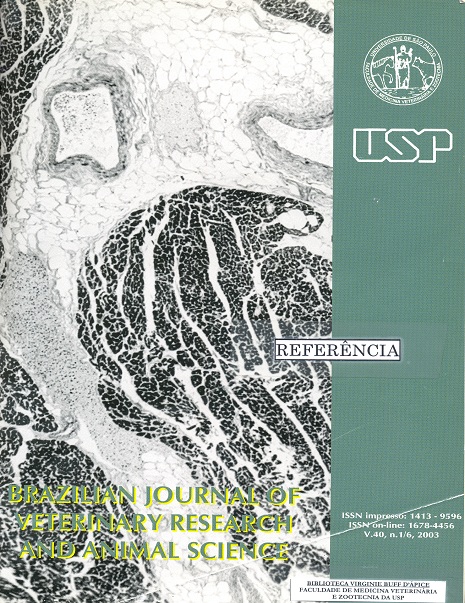Morphometric correlation of the ovary of bovine females on different reproductive stages
DOI:
https://doi.org/10.1590/S1413-95962003000200006Keywords:
Bovine, Ovary, Follicles, Corpus luteum, MorphologyAbstract
The aim of this study was to evaluate morphometric characteristics of bovine ovaries recovered on different reproductive stages. The ovaries used (N=200) were recovered at slaughterhouses and sent to the laboratory, were the size of the ovary, of follicles and of corpus luteum were measured. The pairs of ovaries were classified according to the reproductive stage, and to the estrous cycle or pregnancy stages of the animals from which they were recovered. There was a difference (P;0,05) on organ size between animals presenting estrous cycles or pregnancy, but pregnant cows presented larger corpora lutea and smaller diameter of the largest follicle (P<0,05). Evaluated parameters were affected by estrous cycle and pregnancy stages (P<0,05). There was a significant correlation between ovary and corpus luteum sizes in the animals presenting estrous cycles (R=0.69; P<0,001). In conclusion, ovarian morphologic characteristics changes according to the reproductive stages, could be used as parameters for clinic and functional evaluations of the organ.Downloads
Download data is not yet available.
Downloads
Published
2003-01-01
Issue
Section
UNDEFINIED
License
The journal content is authorized under the Creative Commons BY-NC-SA license (summary of the license: https://
How to Cite
1.
Nascimento AA do, Pinheiro NL, Sales A, Viana JHM. Morphometric correlation of the ovary of bovine females on different reproductive stages. Braz. J. Vet. Res. Anim. Sci. [Internet]. 2003 Jan. 1 [cited 2025 Dec. 31];40(2):126-32. Available from: https://revistas.usp.br/bjvras/article/view/11373





